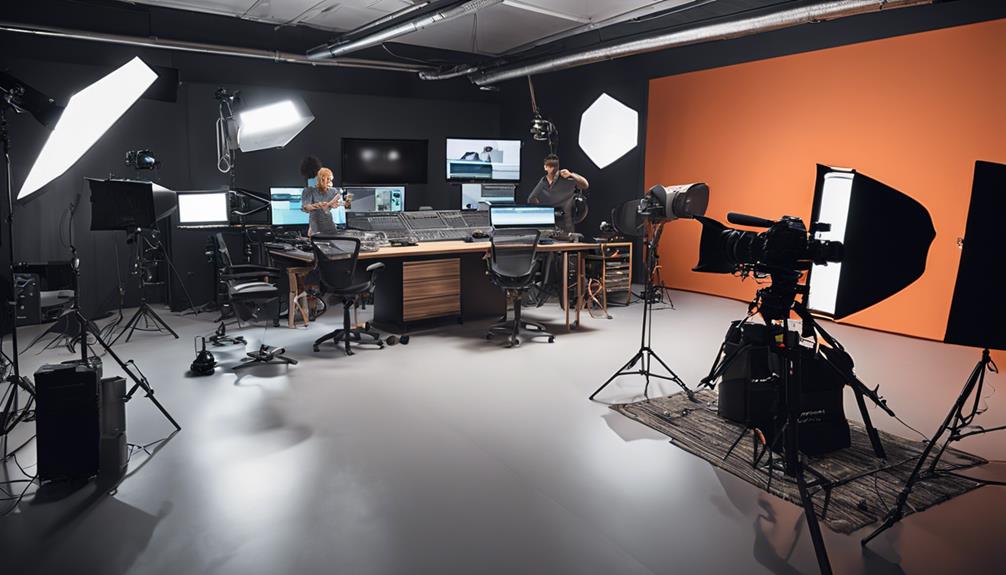No products in the cart.
You can save up to 80% of your time and boost your marketing efficiency greatly by introducing automated ad creation to your strategy. This method not only minimizes human errors but also increases your productivity by enhancing real-time targeting and workflow efficiency. With automated tools, you’ll maintain consistent brand messaging across all platforms, optimizing your budget allocation and increasing conversion rates through precision targeting. Automated ad systems allow for dynamic budget management and data-driven decision-making, improving the accuracy of your campaigns and lowering bidding costs. Explore how deeper insights and strategies offer the potential to scale your impact and achieve better outcomes.
Contents
hide
Key Takeaways
- Utilize AI-driven algorithms to reduce manual tasks and minimize errors in ad creation.
- Implement consistent brand messaging across all advertisements to enhance brand recognition.
- Optimize targeting with real-time data to increase ad relevance and conversion rates.
- Leverage automated tools for dynamic budget management and efficient resource allocation.
- Analyze performance with integrated analytics to continually refine and scale campaigns.
Why Automate Your Ads?
Considering the significant time savings and error reduction, automating your ads is a strategic move to enhance efficiency and effectiveness in your advertising efforts. With automated ad creation, you can save up to 80% of the time you’d typically spend on manual tasks. This isn’t just about working faster; it’s about working smarter. By freeing up this substantial amount of time, you can redirect your focus towards more strategic activities, such as analyzing market trends or refining your overall marketing strategy.
Moreover, the use of AI algorithms in automating ads drastically reduces human error, ensuring that your ad content isn’t only produced quicker but also with greater accuracy. This precision leads to increased productivity as your workflows become more streamlined and less prone to mistakes that can set back your campaign timelines and budgets.
Additionally, automated tools help in improved targeting by using real-time data to adjust ad parameters for peak performance. This means your ads aren’t just reaching more people but the right people, thereby increasing the likelihood of achieving higher conversion rates. By integrating automation, you’re not only keeping your brand consistent across various platforms but also maximizing engagement through precision targeting.
Benefits of Ad Automation
You’ll find that ad automation improves efficiency by slashing the time and resources needed for campaign management.
By ensuring consistent brand messaging, automation maintains a unified voice across all platforms, enhancing your brand’s credibility and recognition.
These strategic tools not only streamline your marketing efforts but also allocate your budget more effectively to maximize campaign outcomes.
Enhanced Efficiency
Additionally, ad automation boosts your campaign’s efficiency by greatly reducing manual tasks, thereby saving up to 80% of your time. This significant time savings allows you to focus on strategic decision-making rather than mundane tasks, leading to increased productivity across your marketing efforts.
With the application of AI algorithms, ad automation not only refines your targeting accuracy by 50% but also optimizes your bidding strategies. This results in a 20% cost reduction in real-time bidding environments.
Additionally, campaigns that leverage automation are shown to achieve up to 30% higher conversion rates, maximizing the effectiveness of each ad dollar spent. Ultimately, this technology enables you to scale your advertising efforts, reaching a broader audience more efficiently.
Consistent Brand Messaging
Automated ad creation tools ensure your brand’s messaging remains consistent across all marketing platforms, maintaining essential elements like logos, colors, and fonts with precision. This uniformity is vital for amplifying brand recognition and fostering customer trust.
By automating your ads, you’re not just streamlining the production process; you’re also ensuring that every piece of content aligns with your brand guidelines. This strategic consistency helps mitigate the risk of off-brand messages slipping through, which can dilute your brand identity and confuse your audience.
Additionally, the data-driven approach of ad automation tools makes adherence to brand standards not just a goal, but a measurable outcome, reinforcing your brand’s presence in a competitive marketplace.
Understanding Automated Campaigns
To effectively launch automated campaigns, it’s vital to define your objectives, select your targets, set your budgets, and initiate your ads with precision. You’ll find that targeting optimization is crucial here. By using data-driven techniques, you can pinpoint the demographics most likely to respond to your offers, enhancing the relevance and reach of your campaign. This strategic approach not only improves engagement but also boosts the overall efficiency of your ad spend.
Additionally, budget management plays a pivotal role in the success of your automated campaigns. Leveraging tools like Google Adwords automation, you can dynamically adjust your spending based on real-time campaign performance. This means you’re not just setting a budget; you’re continuously optimizing it to guarantee maximum return on investment. It’s about making smart, informed decisions that keep your costs in check while scaling your impact.
Creating Your First Automated Ad
Let’s explore setting up your first automated ad by precisely defining your objectives, selecting your target audience, choosing your visual assets, and establishing your budget before launch. This systematic approach guarantees that each element is aligned to maximize results and streamline the ad creation process.
First, defining your objectives is vital. Whether you’re aiming for brand awareness, lead generation, or direct sales, clarity in your goals influences every other decision. Next, selecting your target audience allows you to tailor your messaging and design elements effectively. Use data-driven insights to identify demographic and psychographic characteristics that match your ideal customer profile.
Choosing the right visual assets is key to creative optimization. Automation tools, such as AdCreative.ai, assess numerous design options, recommending high-performing visuals based on historical data and performance scores. This not only enhances the appeal of your ads but also aligns with your brand identity.
Key Considerations for Automation
When considering automation for your ad campaigns, it’s crucial to evaluate how these tools can streamline processes and enhance performance metrics efficiently. Before diving in, you’ll need to focus on key considerations to guarantee successful automation implementation and avoid common pitfalls of ad creation automation.
First, consider the scalability of automation tools. They should adapt as your business grows and marketing needs evolve. Next, assess the integration capabilities with your existing systems to guarantee seamless data flow and avoid silos that can hinder performance analysis. Also, be mindful of the learning curve associated with new technologies. Allocate time and resources for your team’s training to maximize the benefits of automation.
Here’s a quick guide to help you navigate these considerations:
| Consideration | Why It Matters | Best Practices |
|---|---|---|
| Scalability | Supports growth without performance loss | Choose flexible, scalable platforms |
| Integration | Ensures cohesive data management | Prioritize tools with API access |
| Training & Usability | Reduces errors and maximizes ROI | Invest in ongoing staff training |
Enhancing Ad Performance
Automated ad creation tools can greatly enhance your campaign’s performance, as evidenced by the potential to achieve up to 14 times higher conversion rates. By leveraging platforms like AdCreative.ai, you’re not just creating ads; you’re strategically positioning your brand to capitalize on AI-powered targeting and personalized messaging. This approach guarantees that your ads aren’t only appealing but also highly relevant to the audience you aim to engage.
Integrating your ad campaigns with major platforms such as Facebook and Google via tools like Zapier, you’re able to streamline the management process, making it seamless to track and enhance ad performance. This integration aids in refining your targeting strategies and optimizing your ads for better engagement and conversion. The ability to produce anywhere from one to 10,000 creatives a month allows for extensive testing and iteration, helping you to pinpoint the most effective elements in your ads.
Tools for Automated Advertising
Exploring Facebook Ad Automation tools like AdEspresso, RevealBot, and Madgicx reveals a suite of features designed to enhance ad creation, testing, optimization, and analytics. You’ll find these tools aren’t only powerful but essential for scaling your advertising efforts efficiently.
Here’s a breakdown of key functionalities:
- Automated Targeting and Creative Optimization: These tools use advanced algorithms to determine the best audience segments and optimize your ad creatives dynamically. This means you’re always putting your best foot forward without constant manual adjustments.
- Bulk Actions: Manage and adjust multiple campaigns simultaneously with bulk actions. This feature saves you considerable time, especially when handling large-scale campaigns across different products or regions.
- AI Audiences: Leverage artificial intelligence to uncover new audience segments that are likely to convert but haven’t been tapped into yet. This proactive approach can significantly uplift your campaign performance.
- Performance Analytics and Reporting: Access detailed reports that provide insights into what’s working and what isn’t. These analytics help you make data-driven decisions to continually refine your advertising strategies.
Getting Started With Automation
How do you effectively initiate your journey into automated ad creation? First, you’ll need to understand both the automation benefits and the potential pitfalls. Automation streamlines your marketing efforts, greatly saving time and resources by reducing manual tasks. Tools like AdCreative.ai not only simplify ad creation but also enhance ad performance by providing creatives with performance scores.
To start, define your advertising objectives clearly. What’re you aiming to achieve with your ads? Next, select your target audience and set a realistic budget. These steps are critical as they guide the automated system in creating relevant and effective ads.
Incorporating automated tools requires integration with existing platforms. AdCreative.ai, for instance, works seamlessly with major platforms such as Facebook, Google, and Zapier, ensuring that your ads are deployed efficiently across various channels. This integration facilitates a smoother workflow and maximizes the reach of your advertising campaigns.
Frequently Asked Questions
How Do You Automate a Marketing Strategy?
To automate your marketing strategy, set clear objectives and use tools for ad creation, content personalization, and behavioral triggers. Analyze data to refine targeting and bidding, ensuring your approach is both strategic and efficient.
Are Automated Ads Worth It?
Yes, automated ads are worth it. They enhance user engagement and a thorough cost analysis shows significant ROI improvements. You’ll see time savings and increased ad performance without needing deep design skills.
How Do Automated Ads Work?
Automated ads use AI to optimize your campaigns. They analyze data and adjust in real time, using targeting algorithms and creative optimization to enhance audience reach and improve overall ad performance.
How to Work in Marketing Automation?
To work in marketing automation, you’ll integrate data from multiple sources and track ad performance meticulously. This strategic approach optimizes your campaigns and enhances decision-making through thorough analysis.
Conclusion
Now that you’re familiar with the ins and outs of automated advertising, it’s time to get started. Begin by selecting a tool that aligns with your marketing goals and budget.
Remember, the key to enhancing your ad performance through automation lies in constant testing and data analysis. Don’t just set it and forget it. Keep refining your strategies based on the analytics to guarantee your automated campaigns deliver the maximum ROI.
Ready to streamline your marketing? Let’s get automated!






